The Bulldozer Review: AMD FX-8150 Tested
by Anand Lal Shimpi on October 12, 2011 1:27 AM ESTGaming Performance
AMD clearly states in its reviewer's guide that CPU bound gaming performance isn't going to be a strong point of the FX architecture, likely due to its poor single threaded performance. However it is useful to look at both CPU and GPU bound scenarios to paint an accurate picture of how well a CPU handles game workloads, as well as what sort of performance you can expect in present day titles.
Civilization V
Civ V's lateGameView benchmark presents us with two separate scores: average frame rate for the entire test as well as a no-render score that only looks at CPU performance.
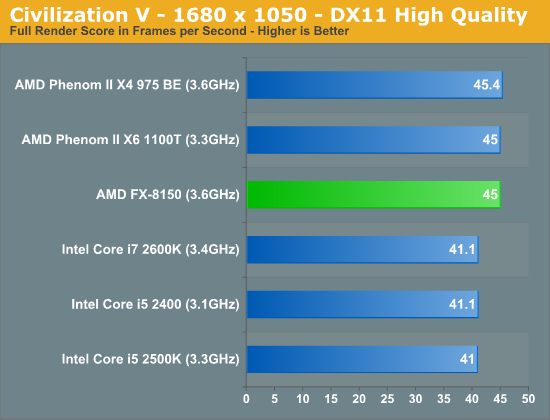
While we're GPU bound in the full render score, AMD's platform appears to have a bit of an advantage here. We've seen this in the past where one platform will hold an advantage over another in a GPU bound scenario and it's always tough to explain. Within each family however there is no advantage to a faster CPU, everything is just GPU bound.
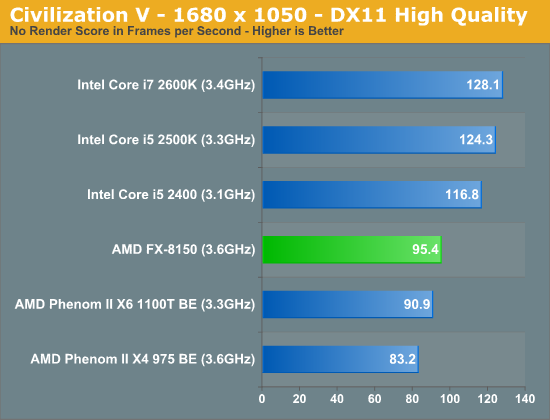
Looking at the no render score, the CPU standings are pretty much as we'd expect. The FX-8150 is thankfully a bit faster than its predecessors, but it still falls behind Sandy Bridge.
Crysis: Warhead
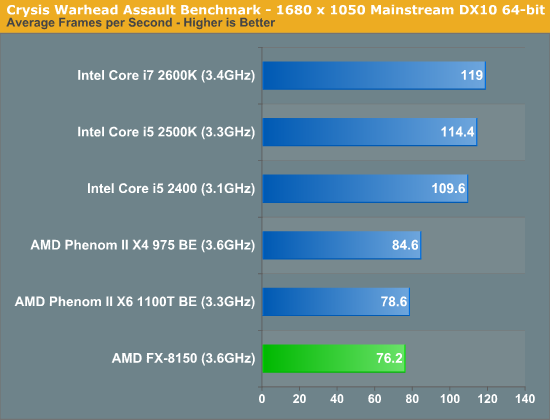
In CPU bound environments in Crysis Warhead, the FX-8150 is actually slower than the old Phenom II. Sandy Bridge continues to be far ahead.
Dawn of War II
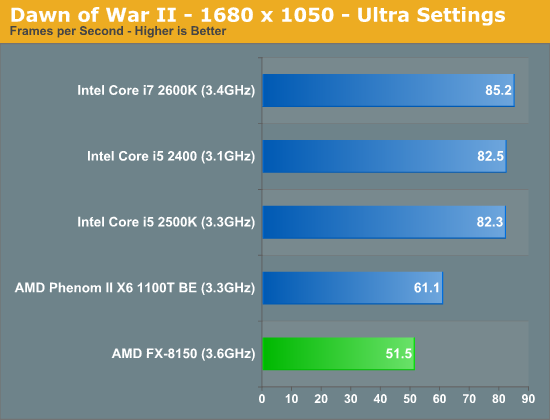
We see similar results under Dawn of War II. Lightly threaded performance is simply not a strength of AMD's FX series, and as a result even the old Phenom II X6 pulls ahead.
DiRT 3
We ran two DiRT 3 benchmarks to get an idea for CPU bound and GPU bound performance. First the CPU bound settings:
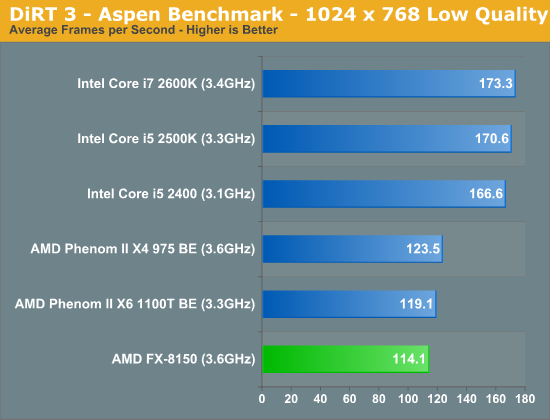
The FX-8150 doesn't do so well here, again falling behind the Phenom IIs. Under more real world GPU bound settings however, Bulldozer looks just fine:
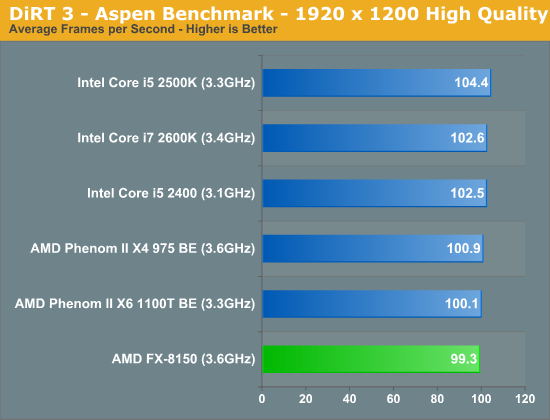
Dragon Age
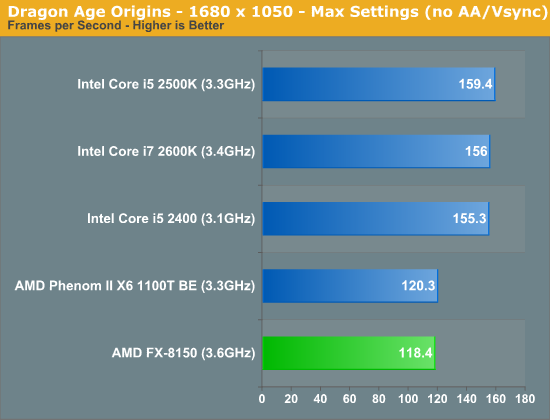
Dragon Age is another CPU bound title, here the FX-8150 falls behind once again.
Metro 2033
Metro 2033 is pretty rough even at lower resolutions, but with more of a GPU bottleneck the FX-8150 equals the performance of the 2500K:
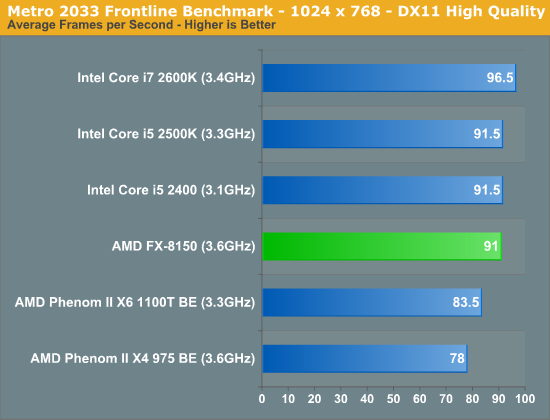
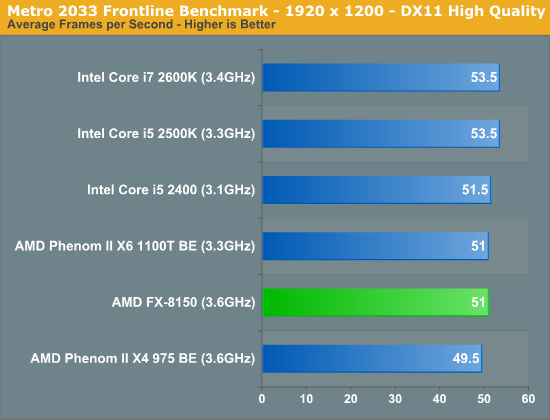
Rage vt_benchmark
While id's long awaited Rage title doesn't exactly have the best benchmarking abilities, there is one unique aspect of the game that we can test: Megatexture. Megatexture works by dynamically taking texture data from disk and constructing texture tiles for the engine to use, a major component for allowing id's developers to uniquely texture the game world. However because of the heavy use of unique textures (id says the original game assets are over 1TB), id needed to get creative on compressing the game's textures to make them fit within the roughly 20GB the game was allotted.
The result is that Rage doesn't store textures in a GPU-usable format such as DXTC/S3TC, instead storing them in an even more compressed format (JPEG XR) as S3TC maxes out at a 6:1 compression ratio. As a consequence whenever you load a texture, Rage needs to transcode the texture from its storage codec to S3TC on the fly. This is a constant process throughout the entire game and this transcoding is a significant burden on the CPU.
The Benchmark: vt_benchmark flushes the transcoded texture cache and then times how long it takes to transcode all the textures needed for the current scene, from 1 thread to X threads. Thus when you run vt_benchmark 8, for example, it will benchmark from 1 to 8 threads (the default appears to depend on the CPU you have). Since transcoding is done by the CPU this is a pure CPU benchmark. I present the best case transcode time at the maximum number of concurrent threads each CPU can handle:
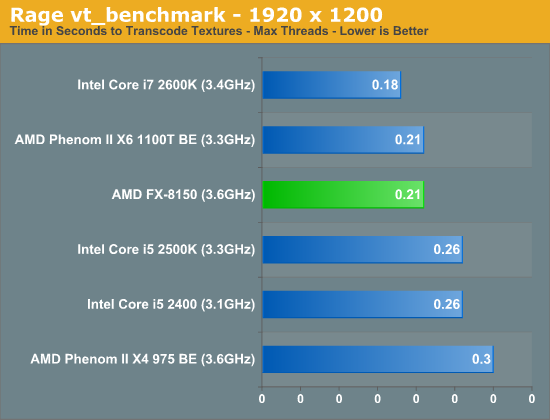
The FX-8150 does very well here, but so does the Phenom II X6 1100T. Both are faster than Intel's 2500K, but not quite as good as the 2600K. If you want to see how performance scales with thread count, check out the chart below:
Starcraft 2

Starcraft 2 has traditionally done very well on Intel architectures and Bulldozer is no exception to that rule.
World of Warcraft
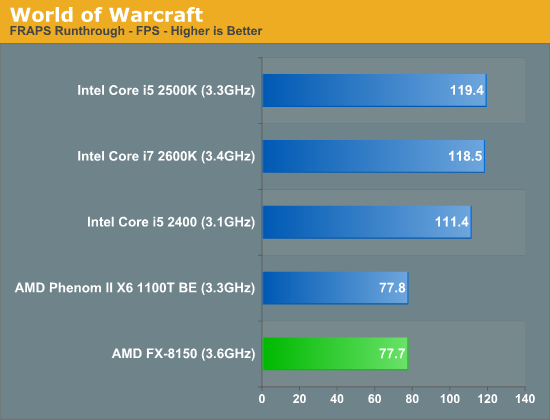


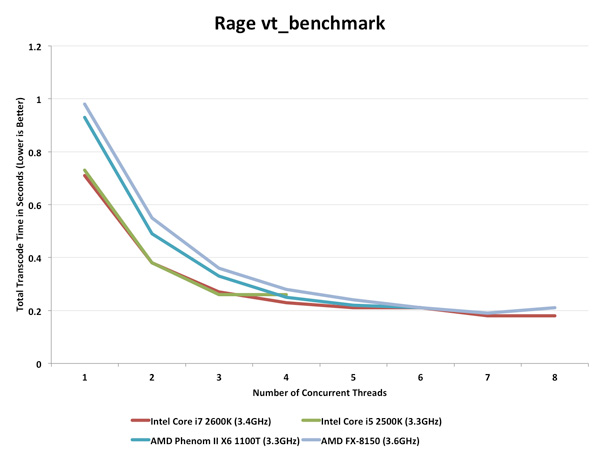








430 Comments
View All Comments
silverblue - Monday, October 17, 2011 - link
The reason for mentioning the 2600 is because that's the only comparison we have for the moment. I don't expect Valencia to use as much power as Zambezi even on a clock-for-clock basis.Pipperox - Monday, October 17, 2011 - link
That has to be seen.Bulldozer's HUGE 16MB of total cache surely were not put there for desktop workloads.
xineis - Sunday, October 16, 2011 - link
I am quite disappointed with the overall performance. And specially with gaming performance.But what about that rumored patch fix for the BDZ? Has any of you guys at AnandTech heard of that?
silverblue - Sunday, October 16, 2011 - link
You mean this one?http://quinetiam.com/?p=2356
Interesting if it's true, however it's doubtful to help across the board (pun not intended). Still, very good news for those doing rendering/encoding.
richaron - Sunday, October 16, 2011 - link
I never want to see a link to that dickbag again..His blogs about WW3, bigfoot, & 2012 should be enough to give you an idea. Also, the dudes at Kubuntu basically do repackaging & KDE integration. They don't touch hardware.
No doubt there can be significant gains through software. But I would rather stab myself through the eyelid than read anything more by that 'person'.
xineis - Sunday, October 16, 2011 - link
Yeah, that one. I know that there is a very slim chance of that 40% boost ever happening, but the idea behind the "patch" is actually plausible.I've seen lots of people explaning how would it work and it looks somewaht legit.
Granted that 40% is too much, but if the right tweaking, I'd be more than happy with 20% to 30% increase in performance!
richaron - Monday, October 17, 2011 - link
everyone would be happy with 20-30%. It doesn't seem realistic to me... but i dropped out of computer engineering :pFrom what I've seen, I would guess about 5% [+/- 5%]
silverblue - Monday, October 17, 2011 - link
Turns out he was one giant troll, or seemingly so. Now, he's pointing the finger at..."Problem solved, it’s just a thermal protection issue, people have been pushing voltages too high. Maybe there’s some variance in mainboard chipsets, but some overclockers and hitting really good numbers."
Really? After all that hoo-har about registry patches, BIOS flashes and the like, we're now blaming thermal protection? I'm taking this with a litre of Dead Sea water.
silverblue - Monday, October 17, 2011 - link
Hey, there has to be somebody somewhere that we can all laugh at. ;)That said, he does sound a bit... odd.
Romulous - Monday, October 17, 2011 - link
perhaps Bulldozer.Next will actually work ;)